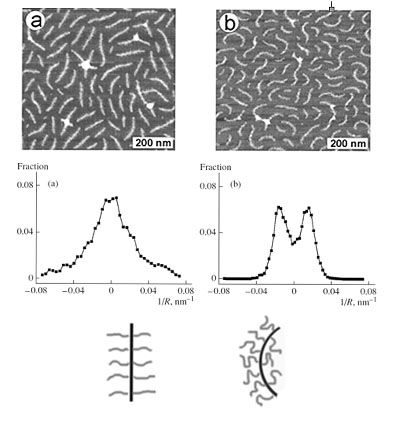Polymers on surface back
back
presence of Surface produces additional interactions, geometrical restrictions and loss of conformational entropy of polymers. It is accompanied by different effects such as spontaneous curvature of the adsorbed macromolecules, formation of chemically heterogeneous surface nanopatterns etc.
Comblike polymers
 Laboratory has an authorship of original studies in the field of the theory of comblike macromolecules (molecular brushes) adsorbed on a surface. We have explained experiments on lateral compression of monolayers of the combs adsorbed on a liquid interface. In such experiments, individual macromolecules collapsed upon compression and formed globules [1]. We have shown that depending on the side chain length, the transition rod(coil)-to-globule proceeds either continuously or discontinuously what coincides with the experimental data [1]. Further studies in the field allowed us to predict new effect: spontaneous curvature of the adsorbed macromolecules [2]. It turns out that at strong (2D) adsorption, the symmetric left-right distribution of the side chains with respect to the backbone is unfavorable due to the entropic reasons. The side chains are less stretched at asymmetric distribution and local curvature of the backbone. This effect was observed in experiments [3]. Theoretical predictions for the persistence length of the adsorbed 2D combs quantitatively support experimental data [4,5].
Laboratory has an authorship of original studies in the field of the theory of comblike macromolecules (molecular brushes) adsorbed on a surface. We have explained experiments on lateral compression of monolayers of the combs adsorbed on a liquid interface. In such experiments, individual macromolecules collapsed upon compression and formed globules [1]. We have shown that depending on the side chain length, the transition rod(coil)-to-globule proceeds either continuously or discontinuously what coincides with the experimental data [1]. Further studies in the field allowed us to predict new effect: spontaneous curvature of the adsorbed macromolecules [2]. It turns out that at strong (2D) adsorption, the symmetric left-right distribution of the side chains with respect to the backbone is unfavorable due to the entropic reasons. The side chains are less stretched at asymmetric distribution and local curvature of the backbone. This effect was observed in experiments [3]. Theoretical predictions for the persistence length of the adsorbed 2D combs quantitatively support experimental data [4,5].
Experimental evidence of spontaneous curvature. Right after adsorption (a), the optimum curvature of the molecule is equal to zero. The molecules have non-zero curvature after annealing (b). Strong (weak) stretching of the side chains at symmetric (asymmetric) distribution with respect to the backbone.
Molecular motors
 Location of the chain is shown at different moments of time: ta<tb<tc<td. The “black” block is subjected to periodic collapse-readsorption cycles and the “white” block is passive: it is adsorbed on the “light” stripe. Arrow depicts the direction of motion.
Location of the chain is shown at different moments of time: ta<tb<tc<td. The “black” block is subjected to periodic collapse-readsorption cycles and the “white” block is passive: it is adsorbed on the “light” stripe. Arrow depicts the direction of motion.
We have proposed a model of the synthetic molecular motor based on adsorbed diblock copolymer which can directionally move under applied external isotropic field [6]. We have demonstrated that directed motion along the pattern of the substrate is possible, if one of the blocks is stimuli responsive and can periodically be collapsed and readsorbed. The second block is “passive” (it is just adsorbed) and provides anisotropic molecular friction which is responsible for the directed motion.
Surface micelles of block copolymers
We have developed for the first time a theory of ultrathin films to explain behavior of PS-P2,4VP diblock copolymers adsorbed on mica from nonselective dilute solution [7-9]. It turns out that P2,4VP blocks strongly adsorb on the mica forming a monomer-thick layer and PS blocks aggregate with each other. The developed theory quantitatively explained dependence of the nanostructure morphology on composition of the copolymer [7].

Related articles
Macromolecules, 2001, 34, 8354